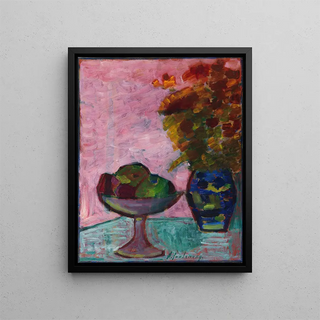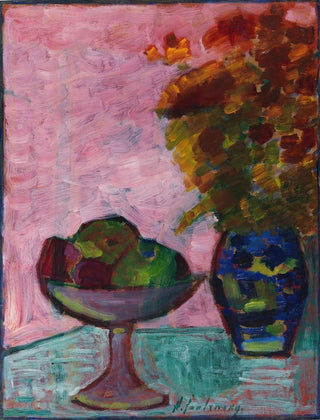Art print Still life with fruit bowl and flower vase - Alexej von Jawlensky | Art print


View from behind

Frame (optional)
Nature morte with a bowl of fruits and a flower vase - Alexej von Jawlensky – Captivating introduction
The still life, an artistic genre often seen as a mere pretext for exploring shapes and colors, transcends this definition here through the work of Alexej von Jawlensky. "Nature morte with a bowl of fruits and a flower vase" serves as an invitation to contemplation, a window into a world where the beauty of everyday objects is elevated. Through this piece, the artist manages to create a dialogue between nature and art, between tangible reality and the emotion it evokes. The viewer is drawn into a universe where each fruit, each flower, seems to tell a story—one that goes far beyond their simple material existence.
Style and uniqueness of the work
What immediately strikes in this nature morte is the harmony of colors and the richness of textures. Jawlensky, known for his expressive approach, uses a vibrant palette that evokes both warmth and vitality. The fruits, with striking realism, seem almost tangible, while the flower vase, through its shapes and colors, adds an airy lightness to the composition. The way the artist plays with light and shadow creates a depth that engages the eye and invites exploration. Every detail, whether it is a delicately placed leaf or a subtle shadow, contributes to the whole, revealing Jawlensky's technical mastery. This work is not just a simple representation; it becomes a celebration of life itself, an ode to the ephemeral beauty of nature.
The artist and his influence
Alexej von Jawlensky, an emblematic figure of the expressionist movement, managed to leave his mark on his era with a unique vision of art. Born in Russia, his artistic journey led him to embrace various influences, ranging from post-impressionism to fauvism. His ability to fuse these styles while developing a personal signature gives him a prominent place in art history. Jawlensky does not merely reproduce reality; he reinvents it, transforming it through the prism of his emotions. His work reflects his time but also projects his inner world.

Matte finish

View from behind

Frame (optional)
Nature morte with a bowl of fruits and a flower vase - Alexej von Jawlensky – Captivating introduction
The still life, an artistic genre often seen as a mere pretext for exploring shapes and colors, transcends this definition here through the work of Alexej von Jawlensky. "Nature morte with a bowl of fruits and a flower vase" serves as an invitation to contemplation, a window into a world where the beauty of everyday objects is elevated. Through this piece, the artist manages to create a dialogue between nature and art, between tangible reality and the emotion it evokes. The viewer is drawn into a universe where each fruit, each flower, seems to tell a story—one that goes far beyond their simple material existence.
Style and uniqueness of the work
What immediately strikes in this nature morte is the harmony of colors and the richness of textures. Jawlensky, known for his expressive approach, uses a vibrant palette that evokes both warmth and vitality. The fruits, with striking realism, seem almost tangible, while the flower vase, through its shapes and colors, adds an airy lightness to the composition. The way the artist plays with light and shadow creates a depth that engages the eye and invites exploration. Every detail, whether it is a delicately placed leaf or a subtle shadow, contributes to the whole, revealing Jawlensky's technical mastery. This work is not just a simple representation; it becomes a celebration of life itself, an ode to the ephemeral beauty of nature.
The artist and his influence
Alexej von Jawlensky, an emblematic figure of the expressionist movement, managed to leave his mark on his era with a unique vision of art. Born in Russia, his artistic journey led him to embrace various influences, ranging from post-impressionism to fauvism. His ability to fuse these styles while developing a personal signature gives him a prominent place in art history. Jawlensky does not merely reproduce reality; he reinvents it, transforming it through the prism of his emotions. His work reflects his time but also projects his inner world.
12,34 €






